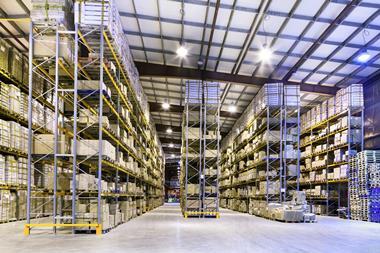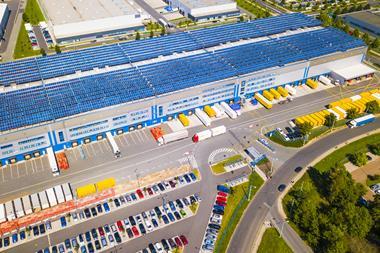Over the past few months, Covid-19 has taken the world by storm with one of the sharpest supply-side economic shocks ever witnessed in modern times.

Policy makers across the globe have responded very aggressively with financial, fiscal and labour market measures to minimise the pandemic’s risks, which could structurally damage economies and jeopardise the world’s financial recovery.

The UK government, along with the Bank of England, has swiftly acted to sustain the labour market while providing more liquidity to businesses. These policies have so far proven to be a lifeline for households and companies alike. However, no one can precisely predict when things will be able to return to normal. Central banks, governments and research houses seem to largely agree that demand will bounce back strongly in 2021. While this would be an ideal scenario, there are downside risks, which could slow this expected recovery.
Assessing the growth trajectory for warehouse demand
The pandemic has emphasised the importance of logistics as the backbone of our economy, and occupiers will have to further embrace how consumer preferences are changing. By the end of May 2020, we had witnessed the strongest-ever growth in ecommerce sales (May 2020 reached £2.19bn vs £1.38bn recorded in May 2019) as companies and consumers adapted to coping in this challenging social and economic environment. According to the Office for National Statistics (ONS), the last and first time online sales broke the £2bn barrier was in December 2019. The acceleration of digitisation, mechanisation and automation will be the next battleground as occupiers review the efficiency of their supply chains.
The logistics sector has demonstrated itself to be extremely resilient and agile in adapting to exogenous shocks. However, despite this, the industry will need to consider the challenges that the manufacturing sector faces over the next 12 months. Manufacturers are operating in an environment where global demand has deteriorated and it will take some time for this to recover to pre-Covid-19 levels. In the short term, these will somewhat prevent the industrial sector from reaching the record levels of occupational activity that were expected this year.
The retail sector has been trying to reinvent itself for the past few years and the Covid-19 pandemic will be an additional catalyst. Simply put, it is now a survival-of-the-fittest scenario – occupiers that are not able to adapt will be left behind
We are currently in the midst of a reset period where retailers are trying to right-size in accordance with their sales volumes per sq ft. The retail sector has been trying to reinvent itself for the past few years and the Covid-19 pandemic will be an additional catalyst. Simply put, it is now a survival-of-the-fittest scenario – occupiers that are not able to adapt will be left behind.
In the short term, social distancing measures and consumer attitudes towards attending crowded places will continue to sustain the demand for online commerce. Colliers expects this step change in online demand to accelerate demand for warehouses. Consumers will become more accustomed to the benefits of buying goods online and occupiers will have to adapt accordingly, hence reviewing their supply chain models to increase capacity.
Furthermore, difficult times and changes bring innovative solutions and, for this reason, we believe there will be a further acceleration in consumer-focused inventions to facilitate this greater consumer appetite for shopping online. Businesses will have no choice but to embrace the omnichannel customer experience, ensuring that they have a strong presence online, even if this means deteriorating profit margins over the short term; it is something that will have to be done to make their brands more resilient and profitable in the long run.
The industrial sector will play a vital role in supporting this change to meet customer expectations. We expect further investment from retailers to future-proof their businesses as they battle with deteriorating business conditions and healthy ecommerce demand.
Last-mile logistics
Demand for urban logistics warehouses has increased dramatically over the past five years and this was taking place right up to the beginning of the Covid-19 outbreak. The initial shock of the pandemic reduced activity for smaller distribution warehouses as some occupiers took a pause from their expansion plans. However, despite this, the market witnessed strong activity for larger distribution warehouses equal to or greater than 100,000 sq ft in Q2 2020.
Nevertheless, we can expect that demand for units sized between 30,000 sq ft and 150,000 sq ft, located in proximity to urban town centres, will return as businesses move from crisis management mode to future planning.

It is estimated that last-mile logistics costs account for about half as much of total shipping costs, while fulfilling online orders requires more than double the space needed to serve the store network. Peak periods are becoming more unpredictable and therefore occupiers need to find scalable and flexible solutions throughout their supply chains. Some retailers’ complacency has left them badly exposed to this shock and it is therefore expected that over the medium to long term, demand for warehouse space will pick up in 2021.
The magnitude of this increased demand will be dependent on the speed of the economy’s recovery, but overall the industrial sector has become less cyclical as occupiers transition more aggressively towards greater capacity to fulfil online orders.
Looking forward
According to the latest estimates from the Office for National Statistics, the UK population is projected to rise to 69.4 million over the decade to mid-2028 and to 72.4 million by mid-2043. It is hard to predict what the next 20 years of advances in technology will have in store, but it is plausible to state that these developments will create an even more enticing omnichannel experience for shoppers.
To serve this extra demand, UK occupiers will need more and better quality space to keep up with the changes. Some consolidation of premises will also occur for those occupiers that have been dealing with legacy issues of their distribution networks as they make their supply chains more agile and efficient.
Regional and national distribution centres will require greater space and perhaps more cubic capacity with an increased use of racking, in some cases, to allow a higher level of mechanisation and automation. Similarly, we will witness more demand for satellite urban logistics units to decrease delivery times. Nevertheless, the supply of available warehouses in the UK remains constrained and the availability of development land has been eroded significantly over the past few years. The planning system will need to become more streamlined in the near future to take into consideration the fact that the provision of warehouse space will become ever more critical in supporting the average consumer’s busy life.
It is, therefore, the customer who is driving demand in the sector and as innovations move forward, this demand is set to remain strong. The key is for developers, agents, landlords, town planners and occupiers to embrace these changes to ensure the industrial and logistics sector continues to serve the ever-changing consumer landscape.
About Colliers International
1. Colliers International is a leading real estate professional services and investment management company
2. Operations in 68 countries
3. More than 18,000 employees provide expert advice to maximize the value of property for real estate occupiers, owners and investors
4. In 2019, corporate revenues were more than $3bn (2019)
5. $33bn of assets under management in our investment management segment (2019)
For more insights from Colliers, including research reports and recent webinar recordings, please visit their website






























No comments yet